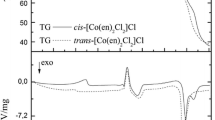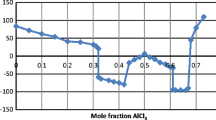Abstract
Purpose. To test the hypothesis that the choice of counterion in salt formation would generally result in a change in the glass transition temperature, Tg, in relation to the nature of the interaction between the ionized parent structure and its counterion.
Methods. Various alkali metal salts of indomethacin (IMC), lithium (Li+), sodium (Na+), potassium (K+), rubidium (Rb+), and cesium (Cs+) IMC were prepared as amorphous solid powders by lyophilization. The Tg was measured using differential scanning calorimetry or modulated-temperature differential scanning calorimetry. The spectroscopic properties of these salts were analyzed using Fourier transform-Raman and Fourier transform-infrared spectroscopy.
Results. A comparison of the Tg values of the five salts showed Tg values in the order of Li+ > Na+ > K+ > Rb+ > Cs+, which is consistent with an order of decreasing ionic radius, and hence an increased charge density and an increased electrostatic interaction energy between the carboxylate ion and the alkali metal cation. Spectroscopic data support this interpretation by showing that the different salts exhibit spectral differences only in the region of the carboxylate group.
Conclusions. Changes in Tg due to salt formation for alkali metal salts of IMC mainly result from differences in ionic interaction between the oppositely charged ions that appear to be related to the size/charge ratio of the counterion.
Similar content being viewed by others
REFERENCES
S. Berge, L. D. Bighley, and D. C. Monkhouse. Pharmaceutical salts. J.Pharm.Sci. 66:1–19 (1977).
E. Nelson. Comparative dissolution rates of weak acids and their sodium salts. J.Am.Pharm.Assoc.Sci.Ed. 47:297–299 (1958).
B. Hancock and G. Zografi. Characteristics and significance of the amorphous state. J.Pharm.Sci. 86:1–12 (1997).
M. D. Ediger, C. A. Angell, and R. N. Sidney. Supercooled liquids and glasses. J.Phys.Chem. 100:13200–13212 (1996).
M. Yoshioka, B. C. Hancock, and G. Zografi. Inhibition of indomethacin crystallization in poly(vinylpyrrolidone) coprecipitates. J.Pharm.Sci. 84:938–986 (1995).
T. Matsumoto and G. Zografi. Physical properties of solid molecular dispersions of indomethacin with poly(vinylpyrrolidone) and poly(vinylpyrrolidone-co-vinyl) acetate. Pharm.Res. 16:1722–1728 (1999).
C. Ahlneck and G. Zografi. The molecular basis for moisture effects on the physical and chemical stability of drugs in the solid state. Int.J.Pharm. 62:87–95 (1990).
P. Tong and G. Zografi. Solid-state characterization of amorphous sodium indomethacin relative to its free acid. Pharm.Res. 16:1186–1192 (1999).
R. Bohmer, K. L. Ngai, C. A. Angell, and D. J. Plazek. Nonexponential relaxations in strong and fragile glass formers. J.Chem.Phys. 99:4201–4209 (1993).
M. G. Bosma, G Brinke, and T. S. Ellis. Polymer-polymer miscibility and enthalpy relaxation. Macromolecules 21:1465–1470 (1990).
K. Khougaz and S. Clas. Crystallization inhibition in solid dispersion of MK-0591 and poly(vinylpyrrolidone) polymers. J.Pharm.Sci. 89:1325–1334 (2000).
D. Lin-Vien, N. B. Colthup, W. G. Fateley, and J. G. Grasselli. The Handbook of Infrared and Raman Characteristic Frequencies of Organic Molecules. Academic Press, Inc., San Diego, California, 1991.
B. Ellis and H. Pyszora. Effect of the metallic ion on the infra-red spectra of salts of carboxylic acids. Nature 181:181–182 (1958).
R. E. Kagarise. Spectroscopic studies of the soaps of phenylstearic acid. I. Infrared absorption spectra and the hydrolysis of soap films. J.Phys.Chem. 59:271–277 (1955).
R. Theimer and O. Theimer. Das Ramanspektrum komplexer organischer anionen in salzpulvern. Monatsh.Chem. 81:313–320 (1950).
J. H. S. Green, W. Kynaston, and A. S. Lindsey. The vibrational spectra of benzene derivatives-i nitrobenzene, the benzoate ion, alkali metal benzoates and salicylates. Spectrochimica Acta 17: 486–502 (1961).
K. Ito and H. J. Bernstein. The vibrational spectra of the formate, acetate and oxalate ions. Can.J.Chem. 34:170–178 (1956).
C. A. Angell, R. C. Stell, and W. Sichina. Viscosity-temperature function for sorbitol from combined viscosity and differential scanning colorimetry studies. J.Phys.Chem. 86:1540–1542 (1982).
Y. H. Roos. Phase transition and structure of solid food matrices. Curr.Opin.Colloid Interface Sci. 3:651–656 (1998).
K. Han and H. L. Williams. Ionomers-The sodium salts of poly (ethylene-co-methacrylic acid). J.Appl.Polymer Sci. 38:73–86 (1989).
Author information
Authors and Affiliations
Rights and permissions
About this article
Cite this article
Tong, P., Taylor, L.S. & Zografi, G. Influence of Alkali Metal Counterions on the Glass Transition Temperature of Amorphous Indomethacin Salts. Pharm Res 19, 649–654 (2002). https://doi.org/10.1023/A:1015310213887
Issue Date:
DOI: https://doi.org/10.1023/A:1015310213887




